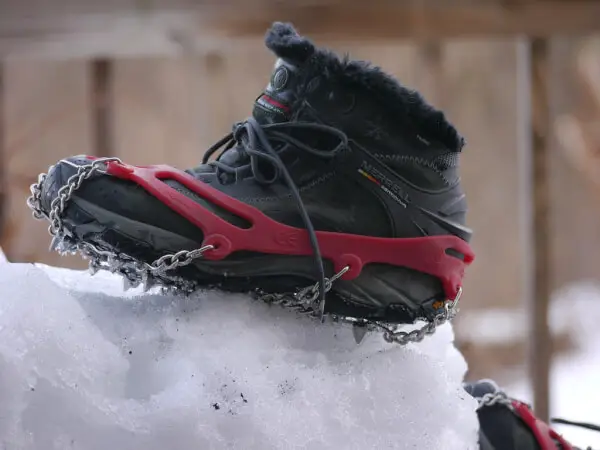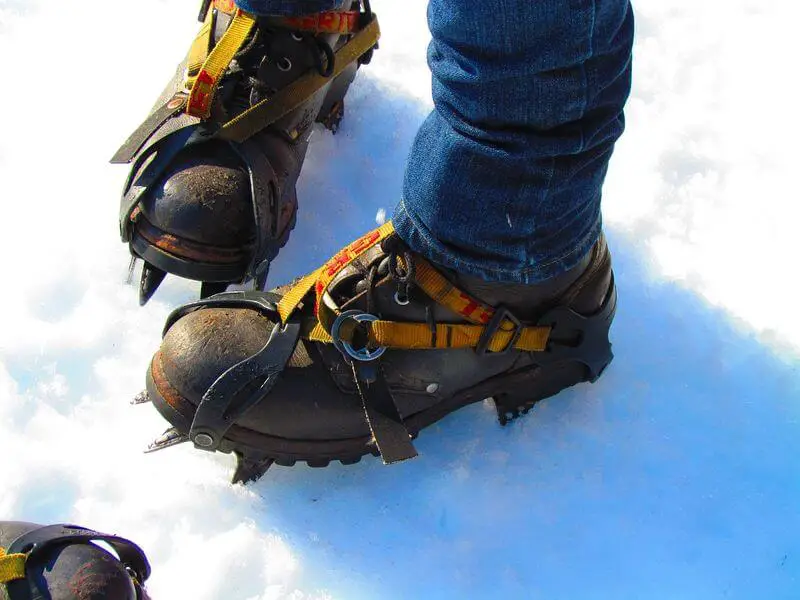So there you are in the dead of winter, hiking to your tree stand or walking around your favorite lake. All of a sudden the trail in front of you becomes icy and your winter boots simply aren’t giving you any traction. The trail gets worse from where you are and you still have two miles left. What do you do now?
There are several types of traction devices for the hunter or winter hiker, many of which are extremely affordable and effective. The two most common traction devices are microspikes and crampons, both of which can be fitted over most types of footwear and add a tremendous amount of traction on icy or snow-covered trails.
Both microspikes and crampons are an affordable way to keep your footing as you trudge through the ice and snow whether on a long family hike or trying to fill your deer tag. So which one you should go for: crampons vs microspikes?
Sorting through the multitude of different products can be a tad daunting, especially with the amount of climbing and mountaineering crampons available. To determine which product is right for you, you must first decide how often and for what purpose you’ll be using them. Are you just walking down an ice covered gravel road or are you trudging through rocky and icy hills?
There are several main differences between microspikes vs crampons, generally related to the spikes themselves. The two biggest differences are the length of the spikes and the location of the spikes on the sole of your footwear. Obviously there are slight differences within each category depending on the manufacturer and design of the devices themselves.
Crampons
Crampons were first developed for climbers and mountaineers looking to scale higher and higher peaks but unable to get proper traction on the snow and ice of the mountain faces. Recently, companies manufacturing mountaineering and climbing crampons have found a new market in the hiking and hunting community.
Trail or hiking crampons have roughly the same design as climbing and alpine crampons opting for shorter, less-aggressive spikes. The result is a lighter traction device, at a more affordable price.
The general design of most crampons includes 8-12 spikes at ½ to ¾ inches long on the outer portion of the sole. The idea behind the design is to allow the user to climb steeper hills in a more natural fashion (using more of your toe and forefoot) while hiking or walking in snow and ice. Depending on the length of the spike, trail crampons make it easier to keep a good grip and maintain balance in the snow when hiking near mountainous terrain.
Recommended Reading: We’ve written a whole article on whether you can use hiking boots in snow that you might be interested in.
Though not as aggressive as crampons used for climbing, trail crampons are still quite aggressive and can be overkill depending on the situation. In general, the best time to use trail crampons is when you plan to be in steep, hilly terrain or when faced with tremendous amounts of ice along the trail.
So if your tree stand is up in the hills, crampons may be the way to go, especially if you’re carrying a heavy pack or pushing/pulling a game cart. Likewise, if you’re scaling a larger hill or small mountain along a trail of ice, it may be best to purchase some crampons to ensure you don’t go tumbling down the hill after climbing up it.
Depending on your needs, crampons can be worth every penny you spend on them and, as with most things, you get what you pay for. There are several ultralight crampons available for those looking to hike serious miles through the snow and ice.
Best for long treks (upwards of 10 miles per day), the ultralight crampons offer the user traction through rough, icy terrain without expending too much more energy. Like traditional ultralight equipment, crampons made for longer treks can be substantially more expensive especially those made from titanium or aluminum.
For those simply looking to hike shorter distances, you can save a decent amount of money by using crampons made of heavier materials. For hunters going to a tree stand or a blind, the heavier crampons may be of more value since, generally, the boots you wear hunting are heavier than the traditional hiking boot anyway.
See also: Best Winter Hiking Boots: Keep your Feet Warm This Winter
The downfall of the cheaper, heavier crampons comes in the design. Typically, these crampons are more difficult to put on and take off due to their one-size fits most design.
Microspikes
A generally less expensive alternative to crampons, microspikes provide traction in icy winter conditions. Not nearly as aggressive, microspikes are designed for flatter terrain such as meadow trails or gravel roads. Designed with more chains and smaller spikes, microspikes have 6-10 spikes ranging from ¼ to ½ inches.

The placement of the spikes generally trends towards the inner sole which makes them better for icy conditions on flatter surfaces. The chains also provide a decent amount of traction to prevent the errant step from causing a fall while walking down the sidewalk.
The design of most microspikes is similar to chains you put over vehicle tires to give them more traction. The best way to understand microspikes is to picture those vehicle chains with small studs in the middle of the chain. They’re particulary useful when snow and ice are mixed.
Typically, microspikes are best used for day to day activities or in areas with little or no terrain such as towns or around the house. The general idea of microspikes is to add traction for activities not involving steep climbs. That’s not to say they can’t or shouldn’t be used for outdoor activities such as hiking or hunting as long as the distances are shorter or the terrain is more forgiving in terms of elevation.
A major benefit of microspikes is their minimal amount of upkeep and maintenance they need on a regular basis. In most cases, microspikes can be cleaned or dried off and be ready to use within a few hours. This also allows you to throw them in the trunk of your car for emergency situations without too much concern for rust or degradation to the spikes themselves.
Purchasing
There are several things to look for when purchasing either microspikes or crampons for the first time, the biggest thing being fit. When attaching either traction device, it is important that they fit snugly against the sole of your footwear.
The worst thing to have happen is getting your traction device of choice firmly planted in the snow or ice and your foot slips within the device itself. This scenario can lead to ankle or knee injuries and can also make it extremely frustrating to walk, rendering the traction device pointless.
Another major thing to look for when purchasing a traction device is how well the device actually stays on your foot and how secure the locking mechanisms are. A device can be very easy to attach to your footwear but snow and ice can accumulate in the locking mechanism causing the device to become unattached and fall off. The last thing you want to do is re-secure your traction device every ten steps because they keep coming undone.
In terms of pricing there are several things to take into account such as material and overall usage of the traction device. The more aggressive the device (i.e.alpine crampons) the more expensive the device will be.
In general, crampons attempt to be as light as possible while maintaining their rigidity so metals such as aluminum and titanium are used for the spikes. As with most outdoor equipment, anything made of titanium will be slightly more expensive for the added benefit of being much lighter than it’s aluminum and steel counterparts.
Microspikes on the other hand are generally comprised of steel parts and so are much less expensive. Though this does make them a bit heavier, depending on the activity for which you plan on using them, the weight of the traction device may be negligible. For example, if you’re plan is to shovel snow around your house or walk from your vehicle to your blind 100 meters away, the heavier, less-expensive steel microspikes may fit your needs the best.
Perhaps the biggest thing to remember when shopping for either microspikes or crampons, and probably the most common sense thing, is the purpose of the traction devices themselves. There’s no need to get aggressive trail crampons for “light duty” such as shoveling the driveway or short walks on level ground to your tree stand or blind.
Nor is it necessary for the more expensive crampons if you only use them once or twice in a season for relatively short durations. Being realistic about their purpose and frequency of use for your traction devices is the best way to avoid overspending and ultimately be happier with your purchase.
Maintenance
Both crampons and microspikes need very little in the way of upkeep and, generally, the most you’ll ever need to do to them in order to ensure their in working order is to let them dry out after a day or weekend of use.
Though steel, aluminum, and titanium are rust resistant, it is still important to keep them dry when not in use. The spikes themselves might be ok, but the buckles and locking mechanisms are often made of cheaper, less rust resistant materials.
The best way to keep your traction device try is to hang them in a moderately warm place for four to six hours. You can put some machine or gun oil on the joints and any moving parts such as the buckles to further prevent rust. Rust in these areas can make it more difficult to secure the traction devices to your footwear.
For crampons it may be a good idea after a certain number of miles (say 100) to sharpen the spikes to make sure they maintain their ability to penetrate ice and snow. This is especially true after rocky or steep trails where the spikes can develop burrs and chips in their edges.
If you’re unfamiliar with how to sharpen the spikes it might be best to take them to your local outdoor or climbing store. Many will let you learn how to properly sharpen them and offers you hands-on practice to ease the process in the future.
So which traction device is right for you?
Remember the snow and ice doesn’t have to be a show stopper for your morning hunts or weekend hiking trips. There are plenty of traction devices out there, ready to make your life a little easier whether you’re climbing steep hills or shoveling the snow off the driveway. Crampons and microspikes are, generally, worth every penny to help keep you from slipping, tripping, or falling when you’re out and about.
If you’re in a region that routinely gets a lot of snow fall or you’d like to start taking weekend trips to the woods in the winter, you should check out your local outdoor store. An up close look may be the most helpful in determining which microspikes or crampons are best for you and your budget.
Remember, as with most outdoor gear, you get what you pay for. So it’s important to strike that healthy balance between quality, features and cost. There’s no need to overspend on crampons when you only need microspikes, nor is it worth it to save money on microspikes when you really need crampons.
The best thing you can do is to determine your needs and intended usage.So make sure that you do your research before buying and find the right fit for you and your needs. So which traction device is better for you? We’d love to hear your opinion in the comment section.
For more tips on hiking in the winter, check out our earlier piece on this topic.
Featured Image Source: https://pixabay.com/photos/hiking-shoes-ice-spikes-glacier-1582295/







